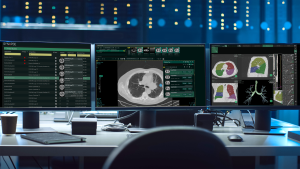As we ring in a new year, it is a fitting time to reflect on where we’ve been and where we’re going, and while this applies to all aspects of life, it’s especially true in our industry.
In the past year, artificial intelligence (AI) made pivotal progress in advancing the field of diagnostic imaging. Let’s take a look back at lessons learned in 2021.
In the last year, AI became real
AI is no longer just a conceptual, “bleeding-edge” technology. Rather, the imaging industry has moved to the early adoption phase. Fujifilm has focused on ensuring that imaging AI can be seamlessly integrated into standard workflows and minimizing distractions from AI as adopters move into day-to-day clinical use. Many clinicians now actively embrace AI, and integration of AI into their workflows is reaping rewards.
2021 saw the start of a culling process. The industry began to assess and choose which AI algorithms are likely to thrive based on those that have already provided real clinical value to radiologists.
Here are the top three imaging areas in which I saw AI adoption and success in 2021:
What lies ahead for the industry regarding AI in 2022? What challenges can we anticipate?
Analytics will be a top priority. Providers want solutions that include analytics overlaid on or integrated with AI to provide real metrics that reflect the value of the algorithm. Healthcare systems will use these analytics to determine their return on investment.
Integrated analytics can answer questions such as “Is AI making our radiologists more efficient? Is it helping them improve diagnoses? Is it improving patient care?”
The focus in 2022 and beyond will be on assessing and advancing AI that helps clinicians work more efficiently. For example, the industry needs to determine how to display relevant data to clinical users at the right time in the most efficient manner. This is especially true as we begin to automatically investigate prior studies using AI to inform the current read. It will be incumbent on vendors such as Fujifilm to determine how to integrate value-added analytics that can quantify the true ROI of AI by building on the existing AI platform foundation.
In the future, we can expect AI applications that are designed to unburden the radiologist by handling some of their daily mundane tasks. AI may even help alleviate radiologist and technologist burnout—a real and significant concern.
There are also two specific challenges that providers will face in 2022: reimbursement and algorithm vendor evaluation
Until the industry figures out AI reimbursement, many providers will fail to adopt the technology. How do they pay for it?
Providers also struggle to determine which algorithms and vendors they should engage. Separating the good from the bad is never easy for new, emerging technology.
While we love to see a community striving for innovation, I recommend health systems turn to their enterprise imaging partners to help vet the AI solutions that will be most valuable to them. Organizations such as Fujifilm recommend consideration of algorithms that have been vetted by clinicians and proven to work in the real-world clinical settings of organizations that have invested in them.
In 2022, Fujifilm will focus on broadening AI adoption, providing a greater variety of internally developed AI algorithms and third-party AI support. We’re presently considering a suite of algorithms versus individual algorithms. Providers can expect “packages” that include multiple, proven algorithms, such as a neuroradiology package that offers automated stroke detection along with other disease detections.
If 2021 was a year of early adoption for AI, we might say that 2022 will be a year of acceleration and advancement
As AI continues to evolve, its potential to transform healthcare becomes increasingly evident—and a powerful source of hope for patients. In 2022 and beyond, Fujifilm plans to advance AI using our flexible solutions to solve difficult healthcare challenges, so that transformation does indeed become a reality. That’s a new year’s resolution our customers can hold us to.